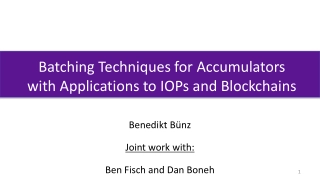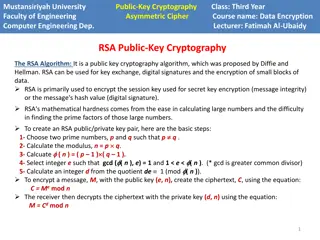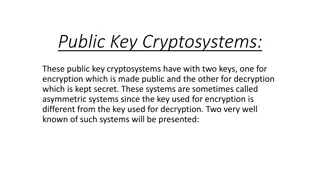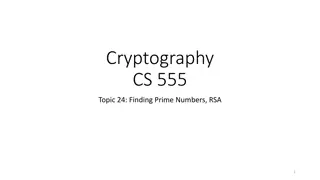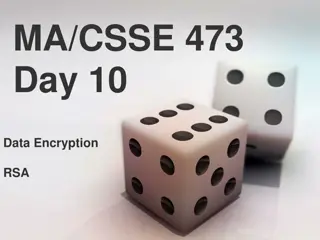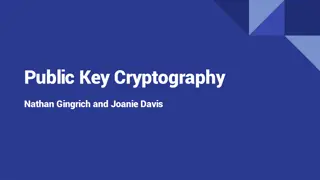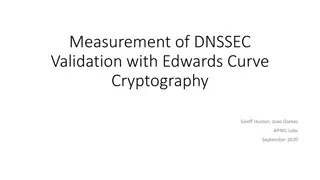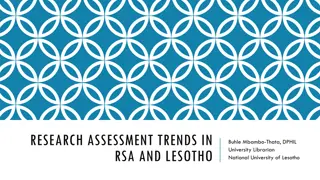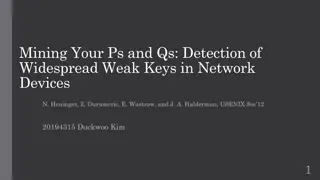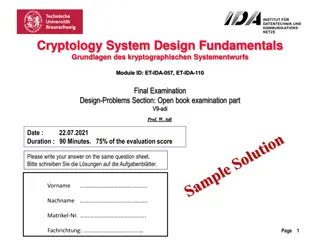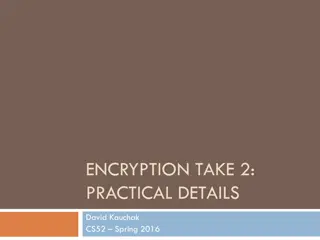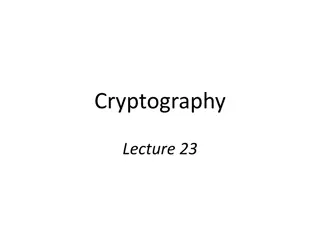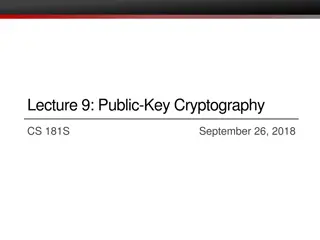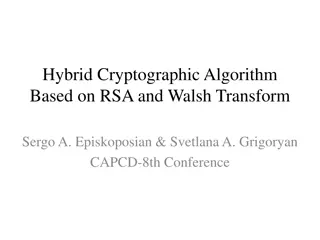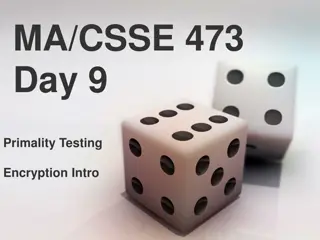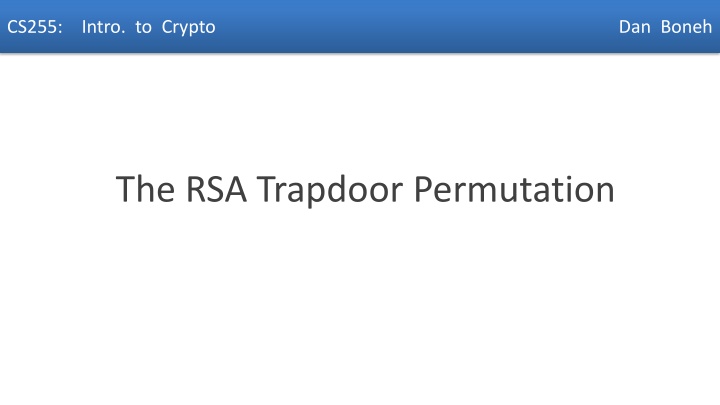
Secure Public Key Encryption from Trapdoor Functions
Explore the concept of trapdoor functions in public key encryption, focusing on the security against chosen ciphertext attacks and the use of secure TDFs. Learn about the construction of public key encryption systems from TDFs and the importance of semantic security in cryptographic protocols.
Download Presentation

Please find below an Image/Link to download the presentation.
The content on the website is provided AS IS for your information and personal use only. It may not be sold, licensed, or shared on other websites without obtaining consent from the author. If you encounter any issues during the download, it is possible that the publisher has removed the file from their server.
You are allowed to download the files provided on this website for personal or commercial use, subject to the condition that they are used lawfully. All files are the property of their respective owners.
The content on the website is provided AS IS for your information and personal use only. It may not be sold, licensed, or shared on other websites without obtaining consent from the author.
E N D
Presentation Transcript
CS255: Intro. to Crypto Dan Boneh The RSA Trapdoor Permutation Dan Boneh
Recap Public key encryption: (Gen, E, D) Gen() (pk, sk) , E(pk, m) c , D(sk, c) m Constructions: (1) ElGamal encryption, (2) today: RSA Security from last lecture: semantic security against an eavesdropper In practice security against eavesdropping is insufficient: adversary can make up ciphertexts and see how recipient reacts Dan Boneh
Security against chosen ciphertext attacks (CCA) A PKE (Gen, E, D) is chosen-ciphertext secure if no efficient adversary can win the following game with non-negl. advantage: ?? ??,?? ???() b {0,1} encryption query: ?0,?1(equal len) adv. ? ?(??,??) chal. decryption queries: ?? ? b {0,1} D(??,??) Thm: ElGamal encryption from last lecture is CCA secure assuming interactive-CDH in G holds, and H is a modeled as a random oracle Dan Boneh
Recap Public key encryption: (Gen, E, D) Gen() (pk, sk) , E(pk, m) c , D(sk, c) m Security: semantic security against a chosen-ciphertext attack Semantic security against adv. that can issue decryption queries Constructions: (1) ElGamal encryption, (2) today: RSA but first: trapdoor functions Dan Boneh
Trapdoor functions (TDF) Def: a trapdoor func. X Y is a triple of efficient algs. (Gen, F, F-1) Gen(): randomized alg. outputs a key pair (pk, sk) F(pk, ): det. alg. that defines a function X Y F-1(sk, ): defines a function Y X that inverts F(pk, ) More precisely: (pk, sk) output by Gen x X: F-1(sk, F(pk, x) ) = x Dan Boneh
Secure Trapdoor Functions (TDFs) (Gen, F, F-1) is secure if F(pk, ) is a one-way function: can be evaluated, but cannot be inverted without sk Chal. Adv. A (pk,sk) Gen() pk, y F(pk, x) x R x X Def: (Gen, F, F-1) is a secure TDF if for all efficient A: AdvOW [A,F] = Pr[ x = x ] < negligible Dan Boneh
Public-key encryption from TDFs (Gen, F, F-1): secure TDF X Y (Es, Ds) : symmetric auth. encryption defined over (K,M,C) H: X K a hash function We construct a pub-key enc. system (Gen, E, D): Key generation Gen: same as Gen for TDF Dan Boneh
Public-key encryption from TDFs (Gen, F, F-1): secure TDF X Y (Es, Ds) : symmetric auth. encryption defined over (K,M,C) H: X K a hash function E( pk, m) : x X, k H(x), c Es(k, m) output (y, c) D( sk, (y,c) ) : x F-1(sk, y), k H(x), m Ds(k, c) output m R y F(pk, x) Dan Boneh
In pictures: Es( H(x), m ) F(pk, x) header body Security Theorem: If (Gen, F, F-1) is a secure TDF, (Es, Ds) provides auth. enc. and H: X K is a random oracle then (Gen,E,D) is CCAro secure. Dan Boneh
Incorrect use of a Trapdoor Function (TDF) Never encrypt by applying F directly to plaintext: E( pk, m) : output c F(pk, m) D( sk, c ) : output F-1(sk, c) Problems: Deterministic: cannot be semantically secure !! Many attacks exist (coming) Dan Boneh
The RSA trapdoor permutation Dan Boneh
Review: arithmetic mod composites Let N = p q where p,q are prime N= {0,1,2, ,N-1} ; ( N)* = {invertible elements in ZN} Facts: x N is invertible gcd(x,N) = 1 Number of elements in ( N)* is (N) = (p-1)(q-1) = N-p-q+1 Euler s thm: x ( N)* : x (N) = 1 Dan Boneh
The RSA trapdoor permutation First published: Scientific American, Aug. 1977. Applications: HTTPS: web certificates ( but less and less so) deprecated for key exchange in TLS 1.3 Dan Boneh
The RSA trapdoor permutation Gen(): choose random distinct primes p,q 1024 bits. Set N=pq. choose integers e , d s.t. e d = 1 (mod (N) ) output pk = (N, e) , sk = (N, d) ; RSA(x) = xe(in N) F( pk, x ): F-1( sk, y) = yd ; yd = RSA(x)d = xed = xk (N)+1= (x (N)) k x = x Dan Boneh
The RSA assumption RSAe assumption: RSAwith exp. e is a one-way permutation For all efficient algs. A: Pr[ A(N,e,y) = y1/e] < negligible where p,q n-bit primes, N pq, y ? R R Dan Boneh
RSA pub-key encryption (ISO std) (Es, Ds): symmetric enc. scheme providing auth. encryption. H: ? K where K is key space of (Es,Ds) Gen(): generate RSA params: pk = (N,e), sk = (N,d) E(pk, m): (1) choose random x in ? (2) y RSA(x) = xe , k H(x) (3) output (y , Es(k,m) ) D(sk, (y, c) ): output Ds( H(RSA-1 (y)) , c) Dan Boneh
Textbook RSA is insecure Textbook RSA encryption: public key: (N,e) secret key: (N,d) me (in N) m Encrypt: c Decrypt: cd Insecure cryptosystem !! Is not semantically secure and many attacks exist The RSA trapdoor permutation is not an encryption scheme ! Dan Boneh
A simple attack on textbook RSA CLIENT HELLO random session-key k Web Browser Web Server SERVER HELLO (N,e) c=RSA(k) d Suppose k is 64 bits: k {0, ,264}. Eve sees: c= ke in N If k = k1 k2 where k1, k2 < 234 (prob. 20%) then c/k1 e = k2 e in N Step 1: build table: c/1e, c/2e, c/3e, , c/234e . time: 234 e is in table. time: 234 Step 2: for k2= 0, , 234 test if k2 Output matching (k1, k2). Total attack time: 234 << 264 Dan Boneh
RSA in practice Dan Boneh
RSA encryption in practice Never use textbook RSA. RSA in practice (since ISO standard is not often used) : ciphertext msg key Preprocessing RSA Main questions: How should the preprocessing be done? Can we argue about security of resulting system? Dan Boneh
PKCS1 v1.5 PKCS1 mode 2: (encryption) 16 bits 02 random pad 00 msg RSA modulus size (e.g. 2048 bits) Resulting value is RSA encrypted Widely deployed, e.g. in HTTPS (TLS 1.2) -- now deprecated Dan Boneh
Attack on PKCS1 v1.5 (Bleichenbacher 1998) PKCS1 used in HTTPS: c= ciphertext c d Is this PKCS1? Web Server Attacker yes: continue no: error 02 attacker can test if 16 MSBs of plaintext = 02 Chosen-ciphertext attack: to decrypt a given ciphertext c do: Choose r N. Compute c re c = (r PKCS1(m))e Send c to web server and use response Dan Boneh
Baby Bleichenbacher compute x cd in N c= ciphertext c d is msb=1? Web Server Attacker yes: continue no: error 1 Suppose N is N = 2n (an invalid RSA modulus). Then: Sending c reveals msb( x ) Sending 2e c = (2x)e in ZN Sending 4e c = (4x)ein ZN and so on to reveal all of x reveals msb(2x mod N) = msb2(x) reveals msb(4x mod N) = msb3(x) Dan Boneh
HTTPS Defense (RFC 5246) Attacks discovered by Bleichenbacher and Klima et al. can be avoided by treating incorrectly formatted message blocks in a manner indistinguishable from correctly formatted RSA blocks. In other words: 1. Generate a string R of 46 random bytes 2. Decrypt the message to recover the plaintext M 3. If the PKCS#1 padding is not correct pre_master_secret = R Dan Boneh
PKCS1 v2.0: OAEP New preprocessing function: OAEP [BR94] msg 01 00..0 rand. check pad on decryption. reject CT if invalid. H + G + {0,1}n-1 plaintext to encrypt with RSA Thm[FOPS 01] : RSA is a trap-door permutation RSA-OAEP is CCA secure when H,G are random oracles in practice: use SHA-256 for H and G Dan Boneh
Subtleties in implementing OAEP [M 00] OAEP-decrypt(ct): error = 0; if ( RSA-1(ct) > 2n-1) { error =1; goto exit; } if ( pad(OAEP-1(RSA-1(ct))) != 01000 ) { error = 1; goto exit; } Problem: timing information leaks type of error Attacker can decrypt any ciphertext Lesson: Don t implement RSA-OAEP yourself ! Dan Boneh
Is RSA a one-way function? Dan Boneh
Is RSA a one-way permutation? To invert the RSA one-way func. (without d) attacker must compute: x from c = xe (mod N). How hard is computing e th roots modulo N ?? Best known algorithm: Step 1: factor N (hard) Step 2: compute e th roots modulo p and q (easy) Dan Boneh
Shortcuts? Must one factor N in order to compute e th roots? To prove no shortcut exists show a reduction: Efficient algorithm for e th roots mod N efficient algorithm for factoring N. Oldest open problem in public key cryptography. Some evidence no reduction exists: (BV 98) Algebraic reduction factoring is easy. Dan Boneh
How notto improve RSAs performance To speed up RSA decryption use small private key d ( d 2128 ) cd = m (mod N) if d < N0.25 then RSA is insecure. Wiener 87: if d < N0.292 then RSA is insecure (open: d < N0.5 ) BD 98: Insecure: priv. key d can be found from (N,e) Dan Boneh
Wieners attack Recall: e d = 1 (mod (N) ) k Z : e d = k (N) + 1 (N) = N-p-q+1 |N (N)| p+q 3 N d N0.25/3 Continued fraction expansion of e/N gives k/d. e d = 1 (mod k) gcd(d,k)=1 can find d from k/d Dan Boneh
Wieners attack Recall: e d = 1 (mod (N) ) k Z : e d = k (N) + 1 (N) = N-p-q+1 |N (N)| p+q 3 N d N0.25/3 Continued fraction expansion of e/N gives k/d. e d = 1 (mod k) gcd(d,k)=1 can find d from k/d Dan Boneh
Wieners attack Recall: e d = 1 (mod (N) ) k Z : e d = k (N) + 1 (N) = N-p-q+1 |N (N)| p+q 3 N d N0.25/3 Continued fraction expansion of e/N gives k/d. e d = 1 (mod k) gcd(d,k)=1 can find d from k/d Dan Boneh
Wieners attack Recall: e d = 1 (mod (N) ) k Z : e d = k (N) + 1 (N) = N-p-q+1 |N (N)| p+q 3 N d N0.25/3 Continued fraction expansion of e/N gives k/d. e d = 1 (mod k) gcd(d,k)=1 can find d from k/d Dan Boneh
RSA With Low public exponent To speed up RSA encryption use a small e: c = me (mod N) ( gcd(e, (N) ) = 1) Minimum value: e=3 Recommended value: e=65537=216+1 Encryption: 17 multiplications Asymmetry of RSA: fast enc. / slow dec. ElGamal: approx. same time for both. Dan Boneh
Key lengths Security of public key system should be comparable to security of symmetric cipher: RSA Cipher key-size Modulus size Elliptic Curve Modulus size 160 bits 80 bits 1024 bits 256 bits 128 bits 3072 bits 512 bits 256 bits (AES) 15360 bits Best factoring algorithm (GNFS): n-bits integer, time Dan Boneh
Implementation attacks Timing attack: [Kocher et al. 1997] , [BB 04] The time it takes to compute cd (mod N) can expose d Power attack: [Kocher et al. 1999) The power consumption of a smartcard while it is computing cd (mod N) can expose d. Faults attack: [BDL 97] A computer error during cd (mod N) can expose d. A common defense:: check output. 10% slowdown. Dan Boneh
An Example Fault Attack on RSA (CRT) A common implementation of RSA decryption: ? = ??in N decrypt mod ?: ??= ?? in p combine to get ? = ??in N decrypt mod ?: ??= ?? in q Suppose error occurs when computing ??, but no error in ?? Then: output is ? where ? = ??in p but ? ??in q (? )?= ? in p but (? )? ? in q gcd((? )? ?,?) = ? Dan Boneh
RSA Key Generation Trouble [Heninger et al./Lenstra et al.] OpenSSL RSA key generation (abstract): prng.seed(seed) p = prng.generate_random_prime() prng.add_randomness(bits) q = prng.generate_random_prime() N = p*q Suppose poor entropy at startup: Same p will be generated by multiple devices, but different q N1 , N2 : RSA keys from different devices gcd(N1,N2) = p Dan Boneh
RSA Key Generation Trouble [Heninger et al./Lenstra et al.] Experiment: factors 0.4% of public HTTPS keys !! Lesson: Make sure random number generator is properly seeded when generating keys Dan Boneh
THE END Dan Boneh

